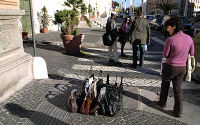Buying Fakes in Italy: Is a fake Gucci bag worth a €10,000 fine?
 Anyone who has walked through the touristy sections of Italy’s major cities has seen them – the peddlers of designer knock-offs who carry enormous black duffel bags and set up “shop” on any vacant patch of pavement. They seem to run in packs, and they’re read to bolt at a moment’s notice if they hear that the police are in the neighborhood. Tourists crowd around them, eager to get a good deal on a fake Prada or Gucci bag, but the goods aren’t even worth the rock-bottom price that’s being charged.
Anyone who has walked through the touristy sections of Italy’s major cities has seen them – the peddlers of designer knock-offs who carry enormous black duffel bags and set up “shop” on any vacant patch of pavement. They seem to run in packs, and they’re read to bolt at a moment’s notice if they hear that the police are in the neighborhood. Tourists crowd around them, eager to get a good deal on a fake Prada or Gucci bag, but the goods aren’t even worth the rock-bottom price that’s being charged.
The police in Italy have been making more of an effort to crack down on these traveling salesmen recently, although the most public form of the effort seems (to me) to be targeted at the wrong end of the stick. Yes, the sellers of knock-offs face arrests and fines if they’re caught, but – as noted above – they often get tipped off when the police are coming through and are rarely caught in the act (seriously, though, if you ask me, any local cops are going to know exactly who they are, if for no other reason than they’re the only ones carrying around enormous black duffel bags – and I’m talking about bags big enough to carry bodies in, so even if the police didn’t find fake Fendis inside, they’d have a good reason to ask for a look-see).
In reality, the people who should be most concerned about these fake goods are the people buying them – because they can and are being slapped with massive fines. There are reports of fines reaching the €10,000 mark – and this is for a bag that you might have paid €30 for – so it’s not something to be sneezed at. The logic for the crackdown is that the industry creating the fakes is hurting the makers of the genuine articles, and not just the people who own the big-name design houses, either. If more people buy fakes than the real thing, that puts the everyday, normal folks who hand-sew or hand-tool the high-priced originals out of work.
But even more than the huge fines you could pay if you’re caught with a knock-off, and more than the toll purchasing knock-offs takes on the designers of the real bags, think of the question of quality for a second. The vast majority of the fakes for sale on Italy’s streets are made in Asia, and are of a pathetically poor quality. You’ll be lucky if that €11 bag you bought lasts 11 weeks. Clearly, in this case, you get what you pay for. And while it obviously will cost many times the knock-off price to buy the real thing, if you’re a smart consumer you’ll either save your euros for a real Prada or you’ll be satisfied with a no-name bag that’s actually been made well.
If you take a chance on a fake in Italy, just remember the hefty fines being levied on buyers – and being a tourist and “not knowing any better” ain’t an excuse they’re willing to accept. Tread wisely.
For more information on the sellers of knock-offs, along with photos of some in Rome, see Shelley’s post.